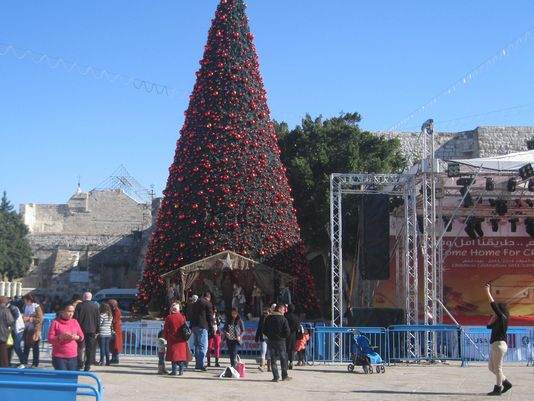By Michele Chabin. Three churches put tensions aside to work together to repair the Church of the Nativity. BETHLEHEM, West Bank — Two weeks before Christmas, one of the most powerful storms to hit the Middle East in a century dumped several inches of snow on the hills of Bethlehem.
In addition to shuttering schools and businesses, the storm caused runoff to trickle down the walls of the Church of the Nativity, built above the traditional birthplace of Jesus.
Fortunately, the water damage was relatively minor, church officials say, thanks to a rare cooperative venture already underway to repair the basilica’s roof, leaky windows and old wooden beams, about 1,500 years old.
“There were still leaks, but thanks to the scaffolding that was erected for the restoration work, the damage was controlled,” said the Rev. Pierbattista Pizzaballa, custodian of the Holy Land for the Roman Catholic Church.
In what some are calling the biggest miracle in Bethlehem since the birth of Jesus, the three churches that share responsibility for the Nativity church put aside centuries of tense relations this past year to ensure the job gets done.
In an act of diplomatic prowess, the Palestinian Authority persuaded the Latin (Roman Catholic), Greek Orthodox and Apostolic Armenian churches to sign an agreement permitting the restoration of the church, whose basilica was built by the Byzantine Emperor Justinian about 600 A.D.
The original Church of the Nativity, built in A.D. 330 by the Roman Emperor Constantine, was mostly destroyed 200 years later. The existing church was built on the same site.
Rainwater has been damaging the church’s infrastructure and artwork for more than a century, but infighting over which church has authority prevented a resolution.
The repairs, being carried out by an Italian restoration company, will cost about $2.6 million. Various governments and donors will foot the bill. But “money was never the main problem,” Pizzaballa insisted.
“The problem was taking personal responsibility,” he said.
The Palestinian Authority launched efforts to bring the churches together after it persuaded UNESCO, the cultural wing of the United Nations, to designate it an “endangered” world heritage site in 2012. The designation is intended for sites that are in imminent danger of collapse.
Israel, which captured the West Bank in the 1967 Middle East war, said UNESCO used the designation to strengthen Palestinian claims over the disputed territory. The Nativity church is the first site under Palestinian control to receive heritage status.
Politics aside, no one disputes that the basilica is in a sorry state. Inside the stone church, the towering walls and 18-foot high columns are discolored and peeling, and the windows let in rain and cold air.
But the most pressing problem is the roof, said the Rev. Peter Vasko, president of the Franciscan Foundation for the Holy Land, a church agency that provides scholarships, subsidized housing and jobs to Christians.
Read the complete article on usatoday.com

